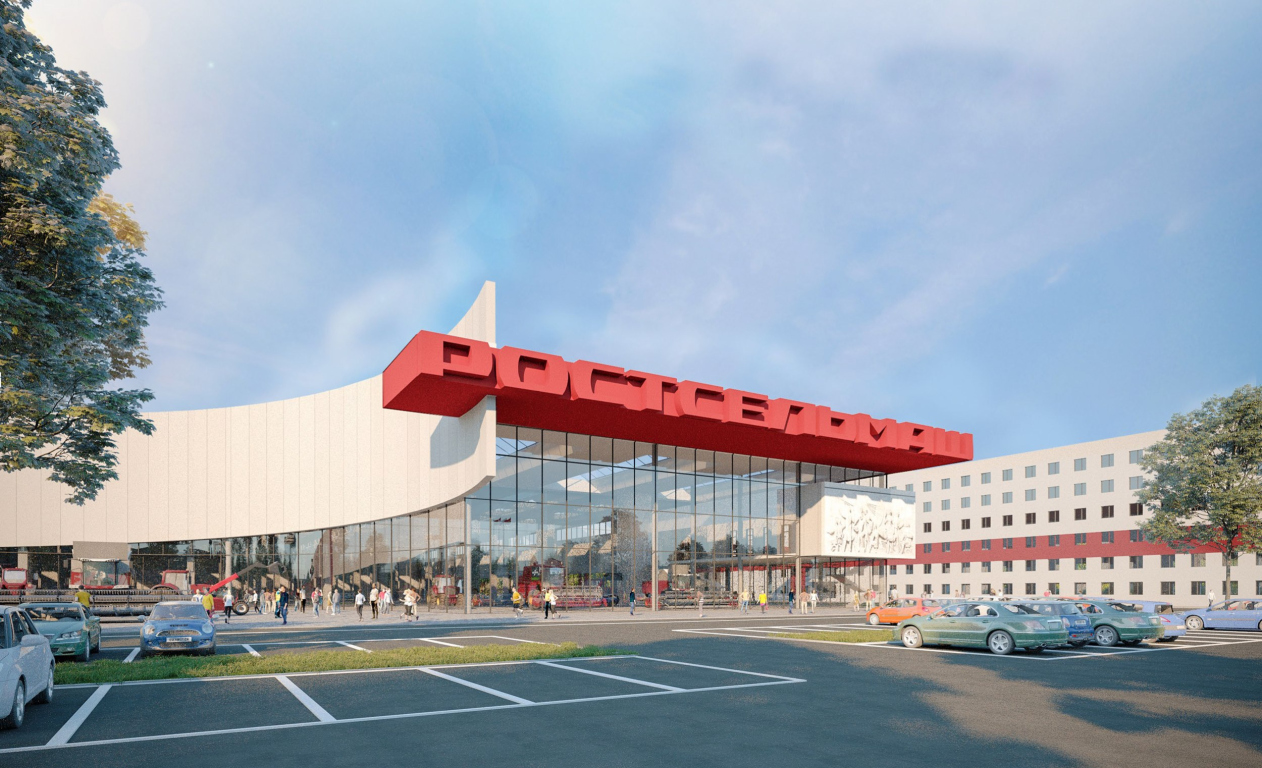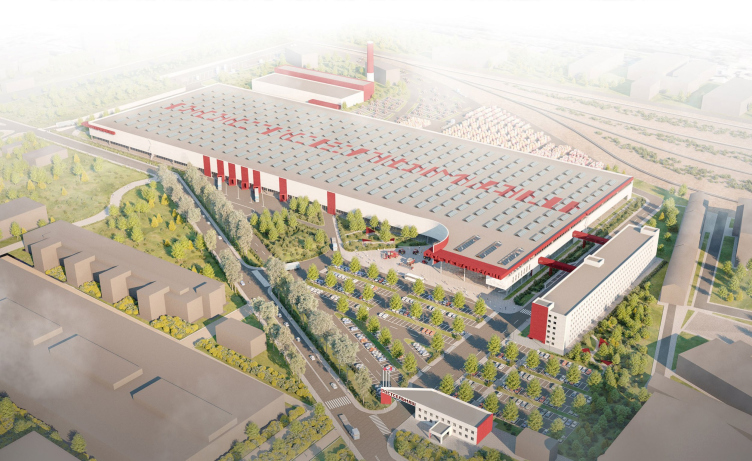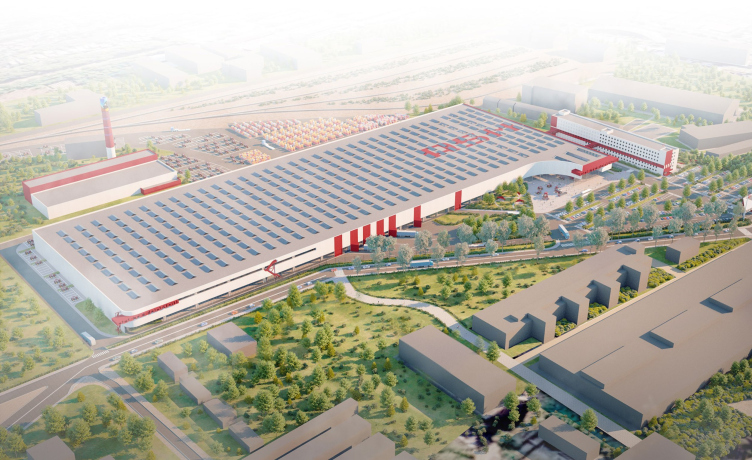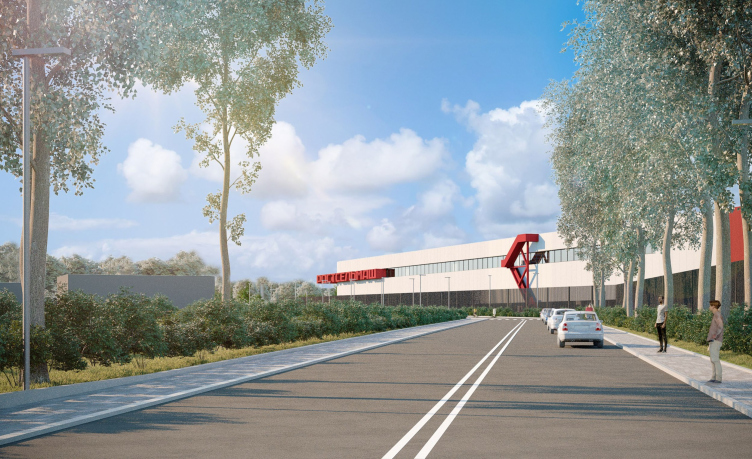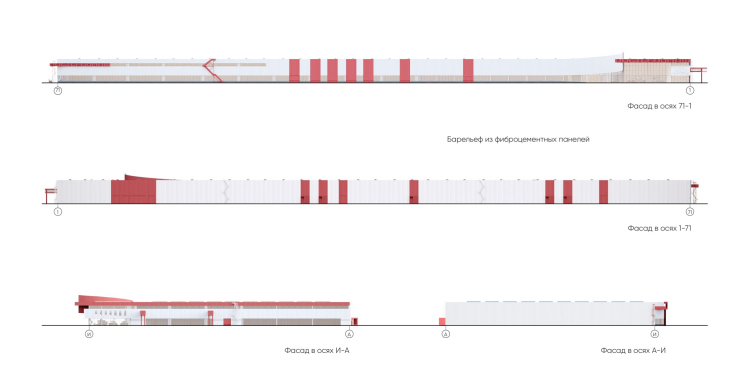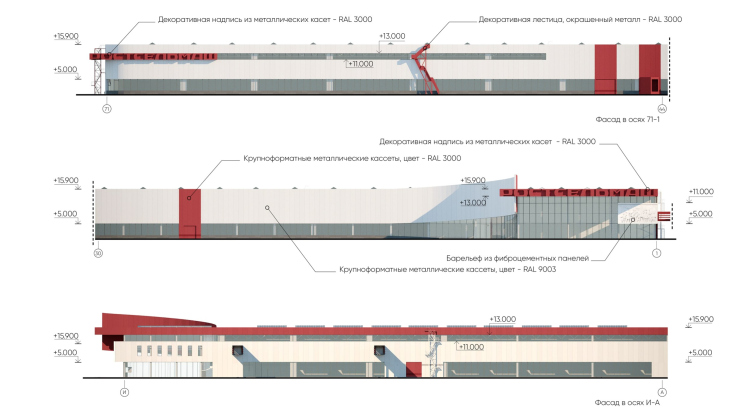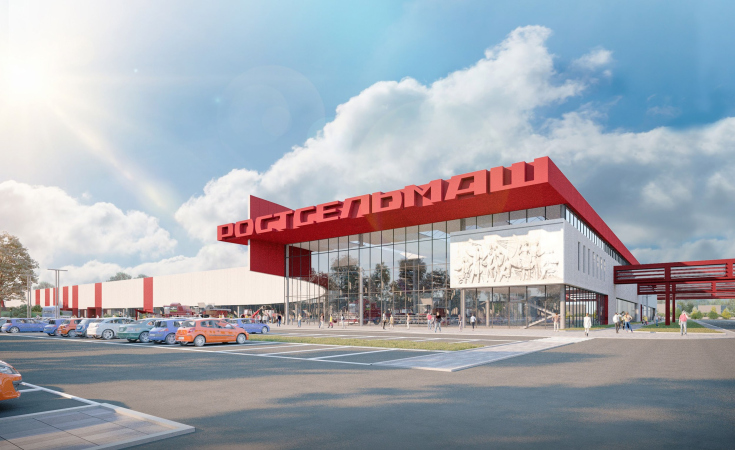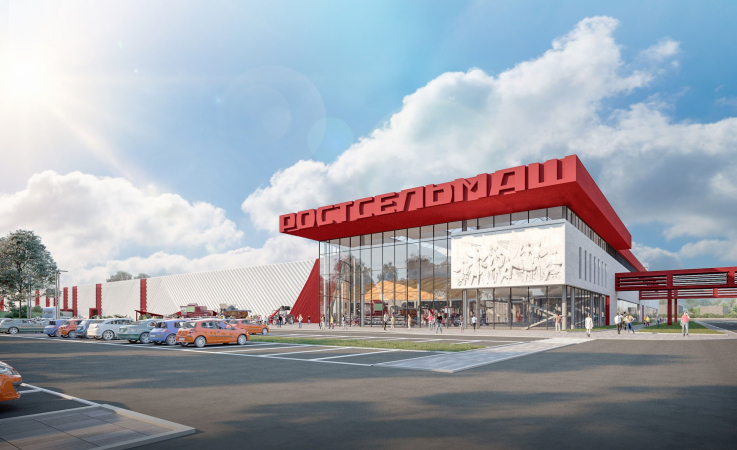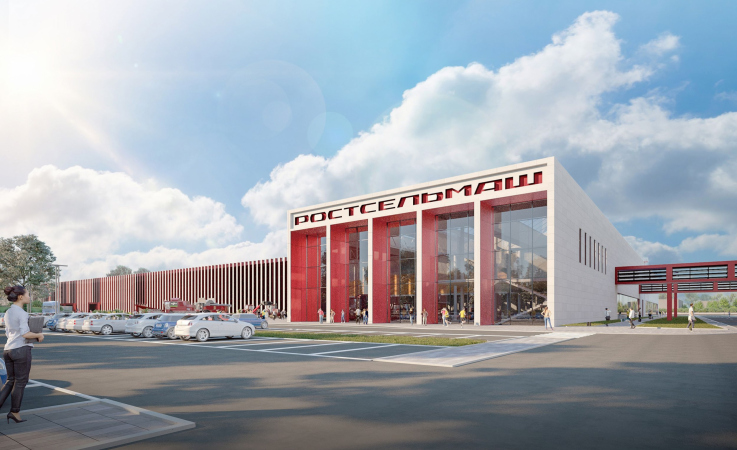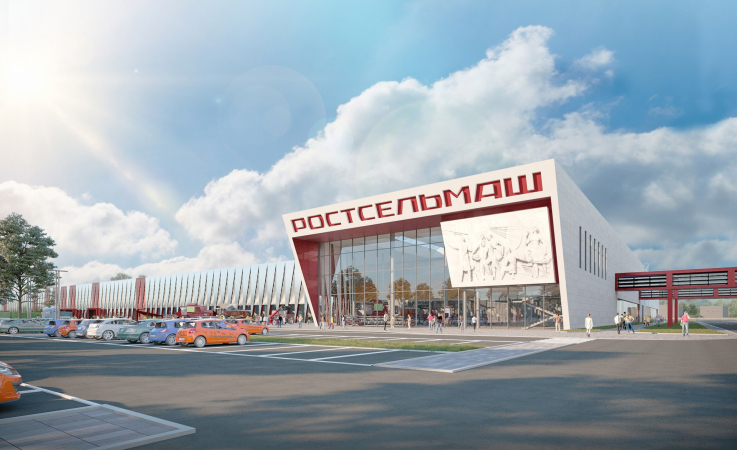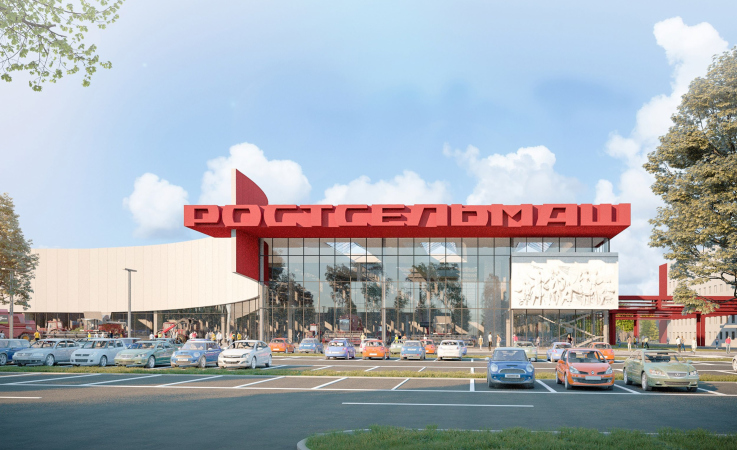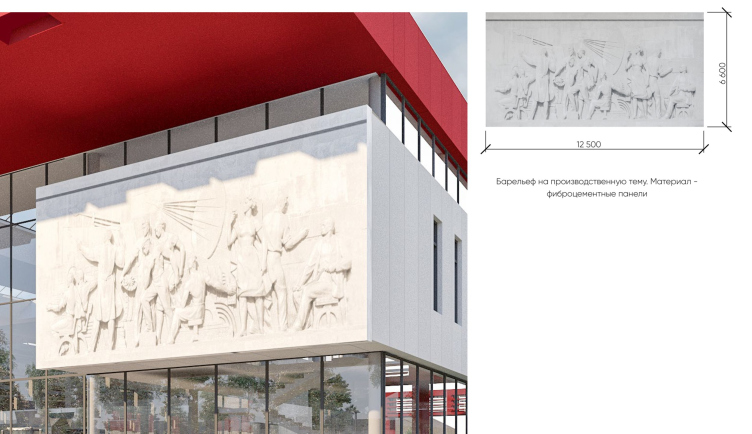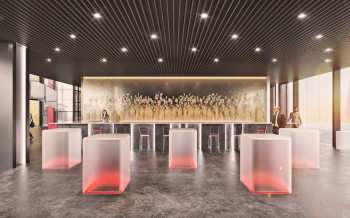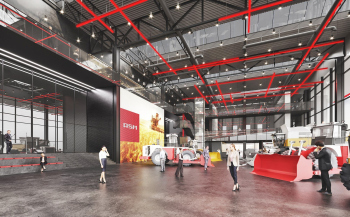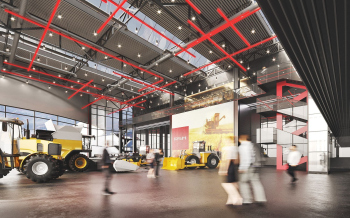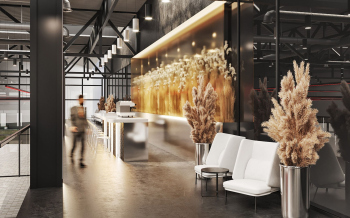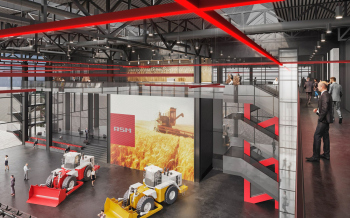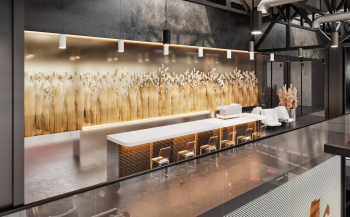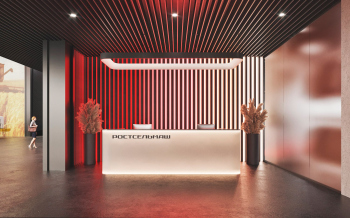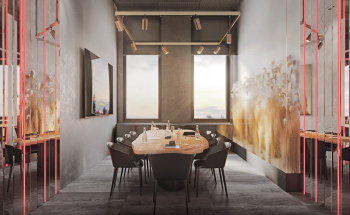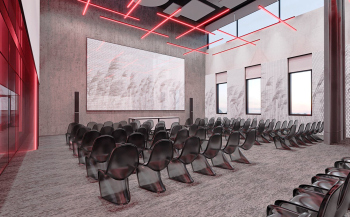The production facility is located in Rostov-on-Don and occupies a large area in the industrial zone between the helicopter plant and the civil aviation plant. One part of this territory has been lying idle for more than 30 years – it is the “Kopnitel” plant, which was started in the perestroika years, but was never completed. In 2021, Rostselmash decided to build a new tractor assembly hall in its place: the transfer and expansion of production will double the output of units from 1,500 to 3,000 per year.
What is unusual is that they decided to make architectural sense of the industrial building, for which they invited the ASADOV Architects.
Reconstruction of the Rostselmash plant. Location in the city
Copyright: © ASADOV Architects
This is, of course, unusual only for modern Russian industrial buildings: there are quite a few Soviet factories, garages or even hydroelectric power plants that have already been included or are asking to be included in the list of cultural heritage sites. Selmash itself, as well as its workers’ settlement, were built in 1927-1931, and at the same time notable constructivist buildings appeared in the city: the Gorky Theater, which Le Corbusier and Oscar Niemeyer called a pearl of Soviet architecture, the Lendvorets, and the residential complexes designed by Mikhail Kondratyev and Leonid Eberg.
It is noteworthy that the customer expressed the wish to pay tribute to Rostov constructivism in the new project.
However, the unfinished “Kopnitel” plant had to be demolished – still, technical requirements for an industrial building are more important than memories. The new assembly hall generally repeats the dimensions of its predecessor, but it has a completely different “shell” answering the needs of the modern production line. The hall, where tractors will be assembled from scratch, is equipped with equipment for welding, machining, painting, and assembly. The existing administrative building, boiler house and entrance group have been preserved, and the facades have been renewed according to the general concept.
Reconstruction of the Rostselmash plant. Variant 1 – general view
Copyright: © ASADOV Architects
Reconstruction of the Rostselmash plant. Variant 1 – general view
Copyright: © ASADOV Architects
The production hall is huge – a rectangular building with impressive sides of 400 by 125 meters and a total area of about 62,000 m2. The long, snow-white facades are interrupted by ribbon glazing, interspersed with inclusions of red. It looks like this: on the main façade, there are juicy sandwich panels that mark the loading and unloading areas; there is an exterior staircase that resembles an enlarged fragment of a bunch of trusses when viewed from a close range, and an arrow when viewed from a distance; finally, there is a brutalist inscription anchoring the corner. The facades on the administration building and warehouse side are also marked by a red ribbon of eaves running the full length of the building. The roof works as “the fifth façade” thanks to the slender rows of skylights. They are protected from direct sunlight by “little houses” made of solar panels of the domestic brand Hevel.
Reconstruction of the Rostselmash plant. Variant 1 – general view
Copyright: © ASADOV Architects
Reconstruction of the Rostselmash plant. Variant 1 – view of the corner of Building B, staircase version 1
Copyright: © ASADOV Architects
Reconstruction of the Rostselmash plant. Facade layouts
Copyright: © ASADOV Architects
Reconstruction of the Rostselmash plant. Fragments of facade sweeps
Copyright: © ASADOV Architects
The simple shape of the building reflects its internal structure: the modern production line is concise, precise and efficient. However, only the paint shop and part of the component warehouse will be stationary, while the rest of the space will be flexible and adjustable.
The building’s entrance is responsible for the first impression that the building produces; the entrance is located in a small ledge relative to the whole building, but still accommodates seven units for display. Judging from the sketches, the entrance area set the tone for the entire concept: among the variants, we can see a modernist sloping portal – or colonnade – supported by ribbed lamellae on the main volume.
The final version is the most balanced one in terms of both mass and message. The glass cube is covered with a red canopy with the name of the company; on the left, the façade curves with a wide flexible arc – on the one hand, it is an effective and laconic architectural gesture, on the other hand, it looks like a banner, as the back side of the arc is red. The movement of the arc is balanced out by a light parallelepiped, housing the conference hall and meeting rooms; it is cut into the stained glass window of the entrance group on the right and “floats” in the glass, opening a view of the thin teeth of concrete stairs leading upstairs – everything is done according to the rules of the chosen style.
On the façade of the conference hall, again in line with modernist preferences, a bas-relief was planned to be placed. Rostselmash even held a contest: its participants had to come up with a composition that would not only welcome guests, “but also inspire employees, being a hymn to creative labor and a man of labor”. The finalists received a serious reward, the models were promised to be left in the Rostselmash museum, but for some reason it didn’t work out – the bas-relief was eventually replaced by media screens.
Reconstruction of the Rostselmash plant. Bas-relief
Copyright: © ASADOV Architects
At the entrance, the visitor is welcomed by a spacious double-height showroom displaying samples of machinery. It is separated from the hall by a transparent story the full height of the building, through which you can observe the working process. The dark monochrome finish helps to focus all of your attention on the technology, while different textures and matte materials make the space look deep and voluminous. The welcome area, conference room and meeting rooms are all united by red details: lamps, gradient lighting, perforated panels. The agrarian theme is further supported by compositions of dried flowers. The overall mood is even somewhat glamorous.
The preserved buildings were renovated and “brought to a single style denominator”: flashes of red on white link the buildings into a single complex. The six-story administrative building will be connected to the assembly halls by two air overpasses running at the third floor level. The main entrance will be framed by a square which will also become an outdoor display for the equipment. It will be complemented by a square for recreation, as well as parking lots protected by shadows cast by the trees.
If we look at the complex as a whole – firstly, the very fact that the client invited the architects and asked them to make homage to modernism/constructivism of the Rostov land is interesting and worthy of praise. Secondly, the modernist note here is stronger and more interesting than the constructivist one, and it is more suitable for the scale of the factory building. In the end, though, they act together and take good root in the Rostov region, where agriculture is an industry with traditions, where everything grows and sprouts and asks to be depicted on “ROSTA posters” thanks to its labor prowess.

